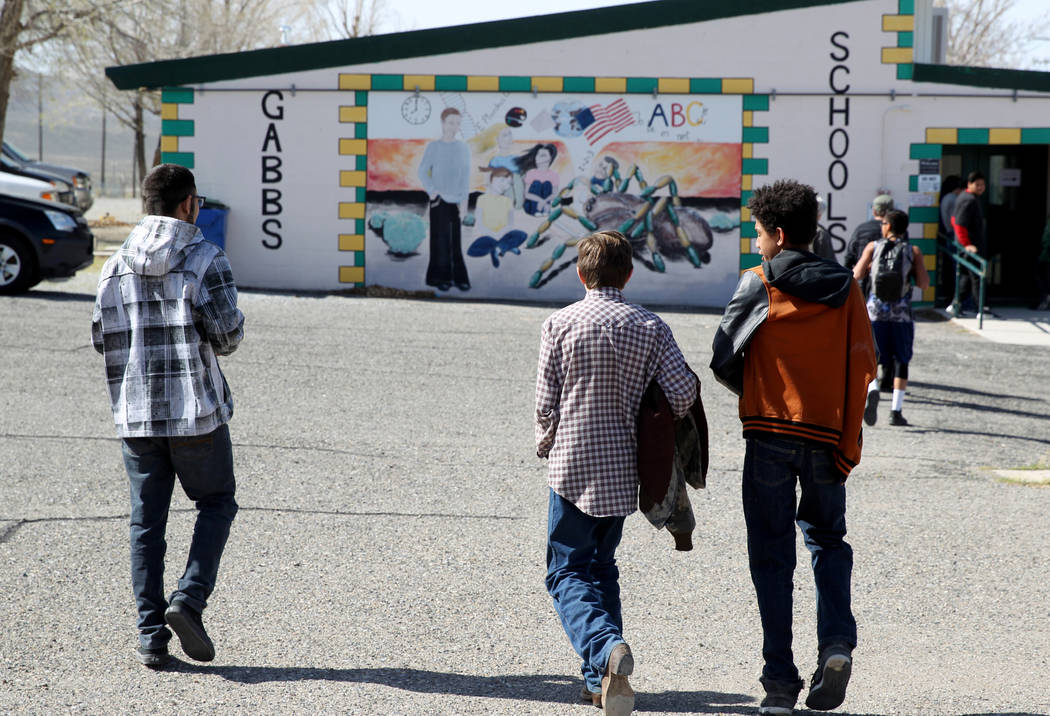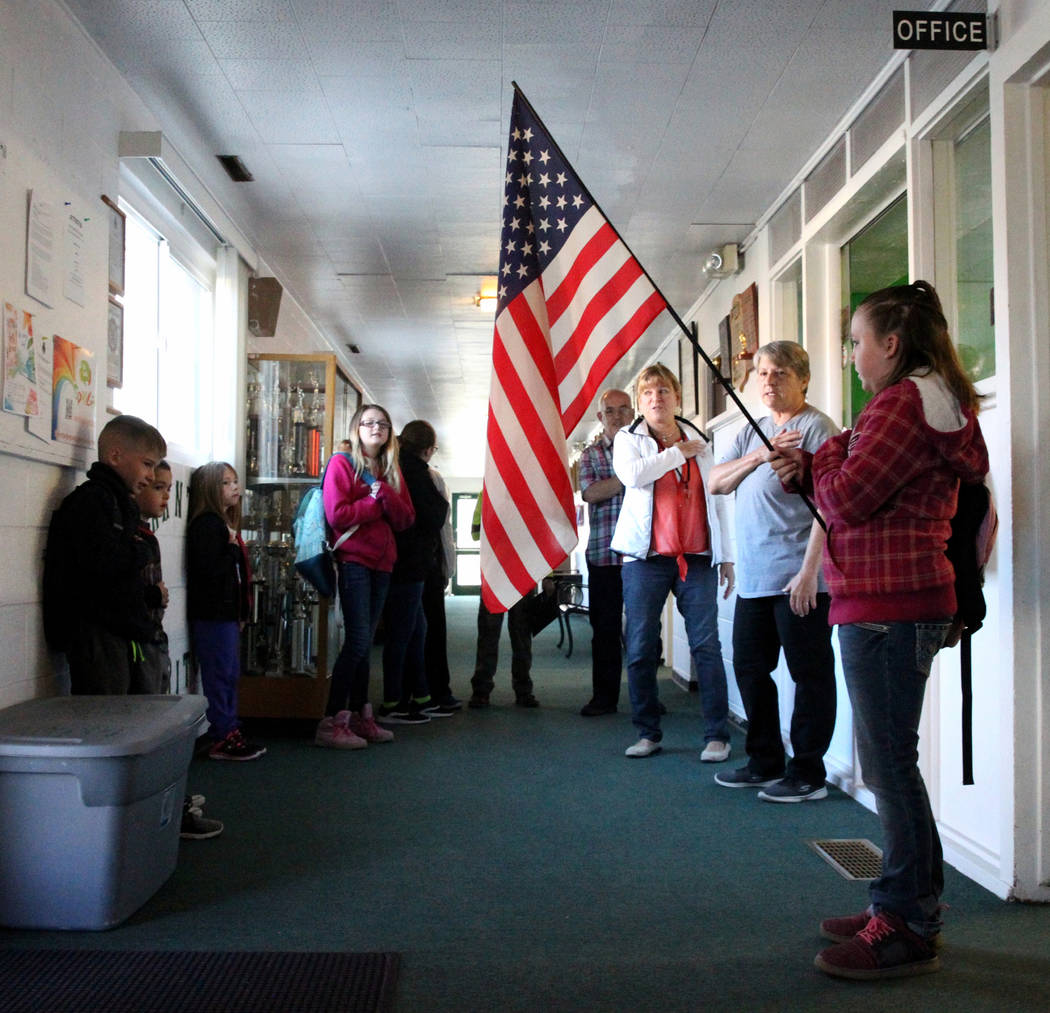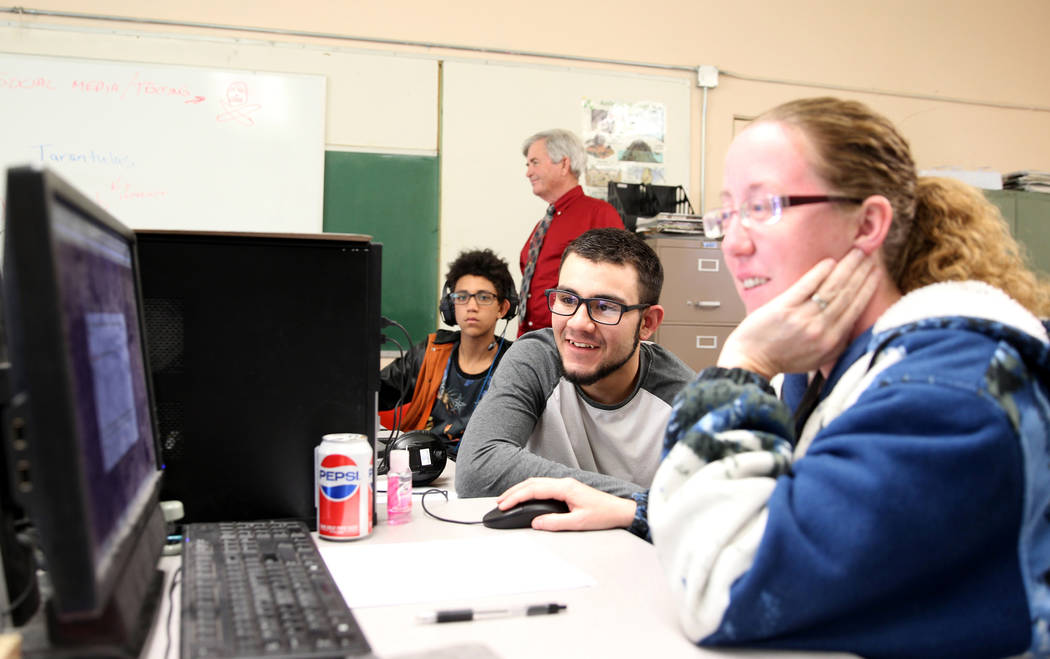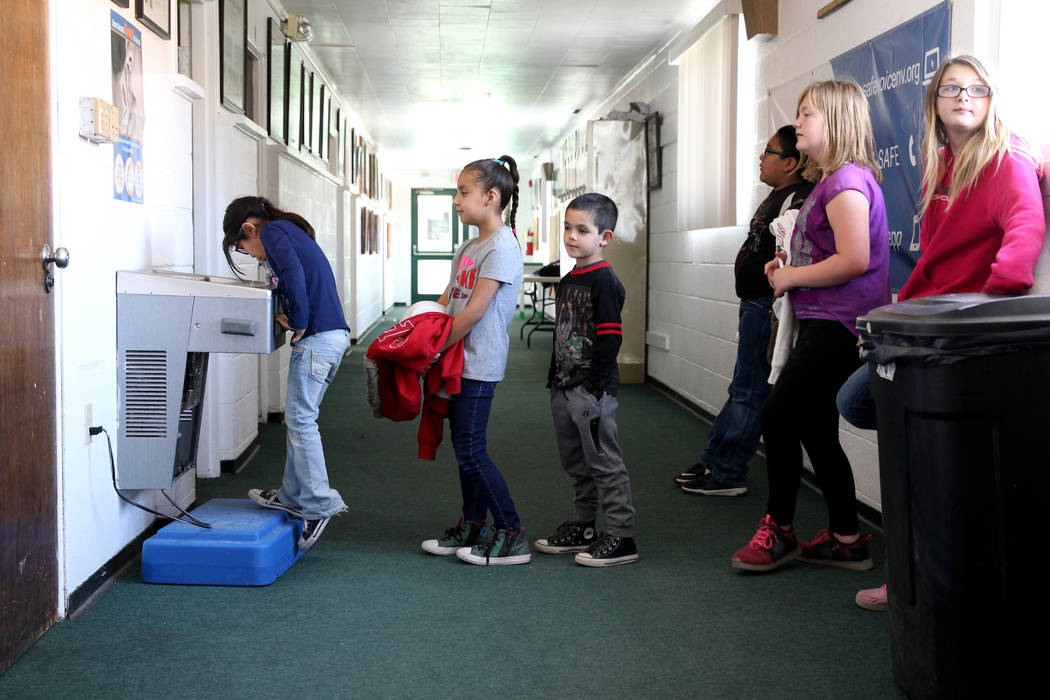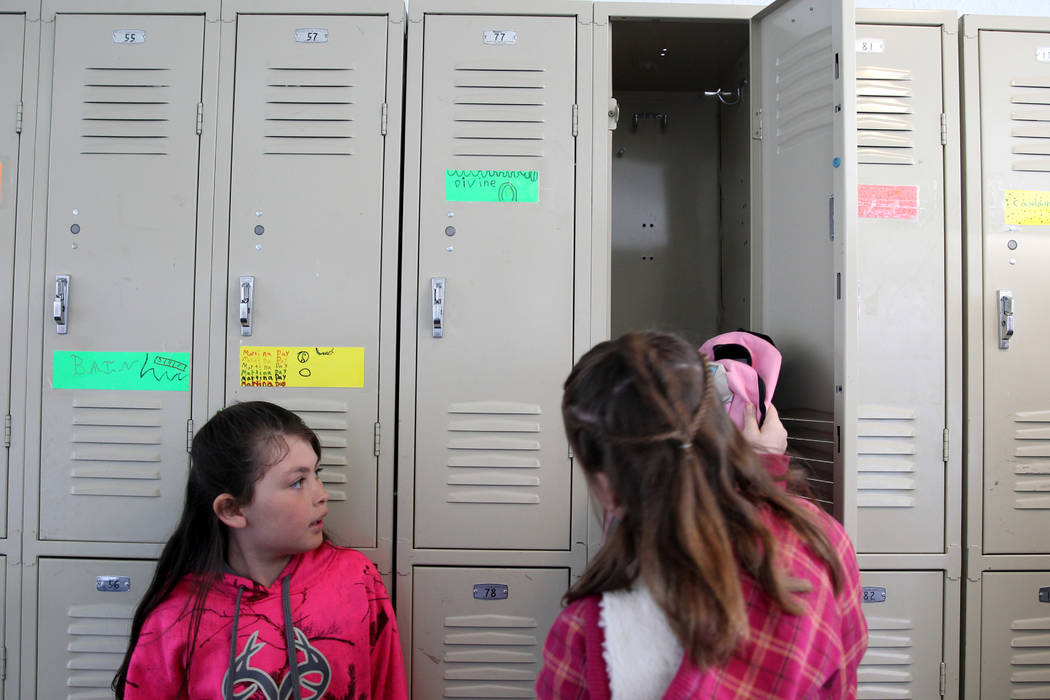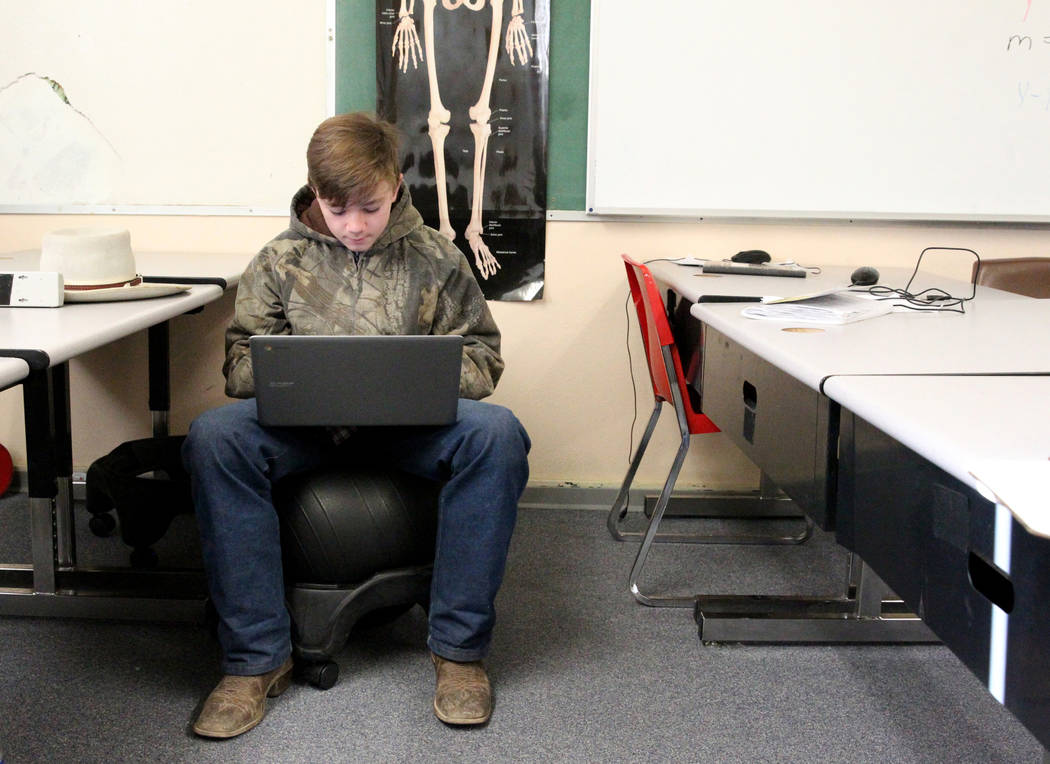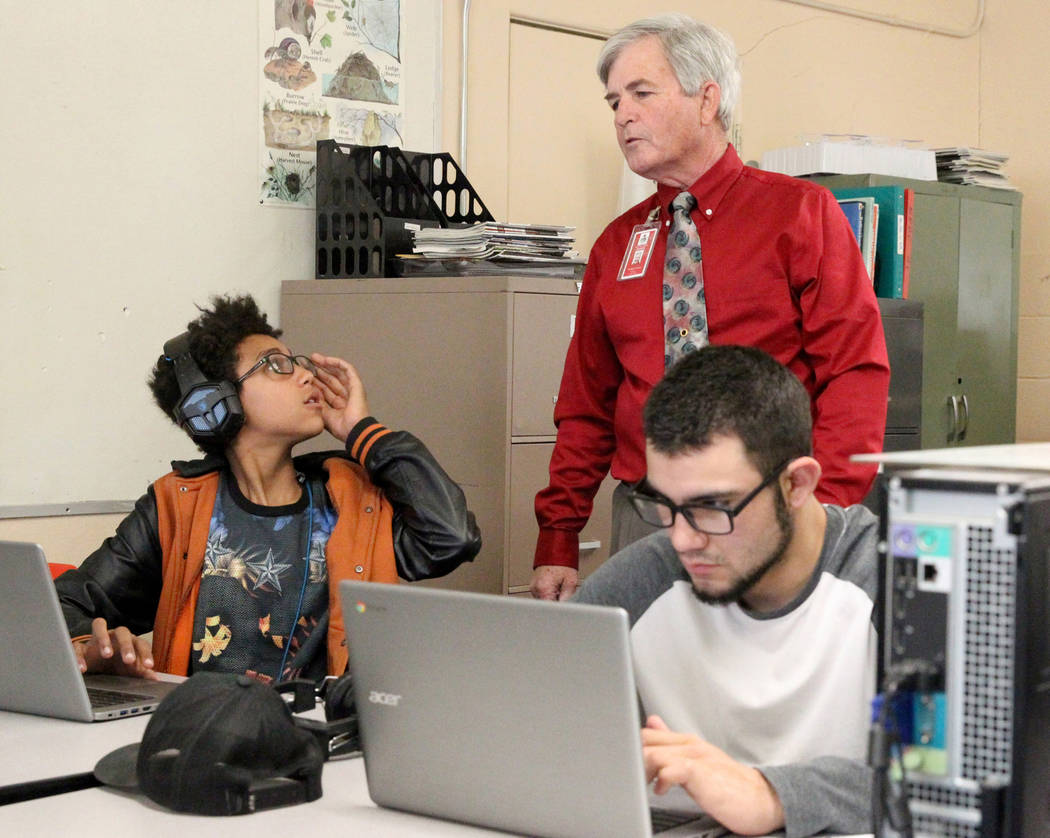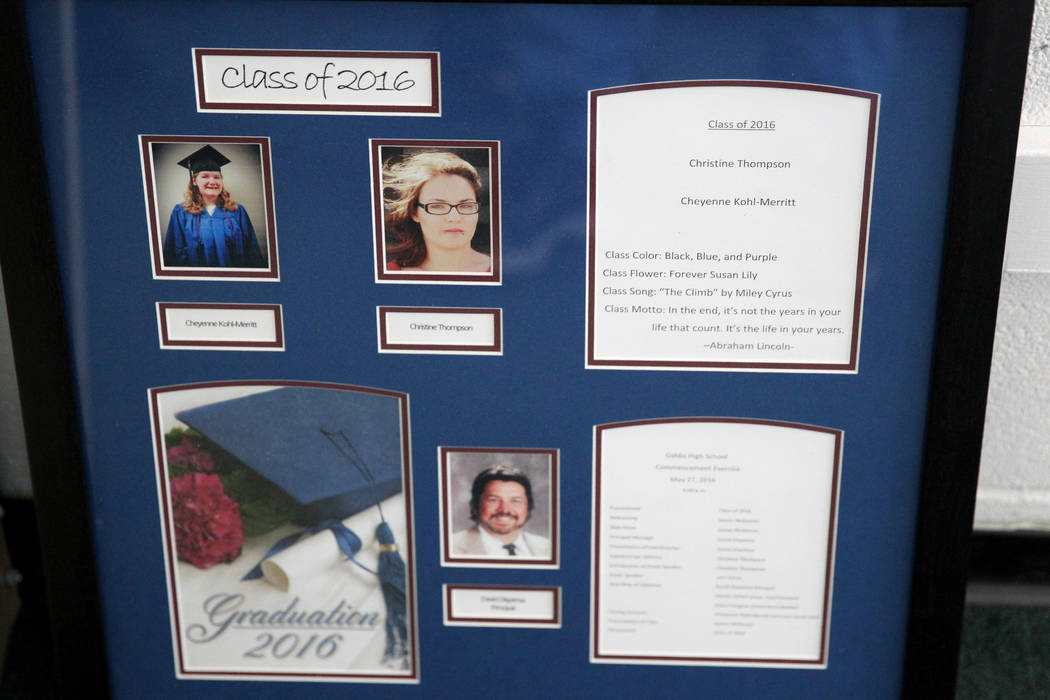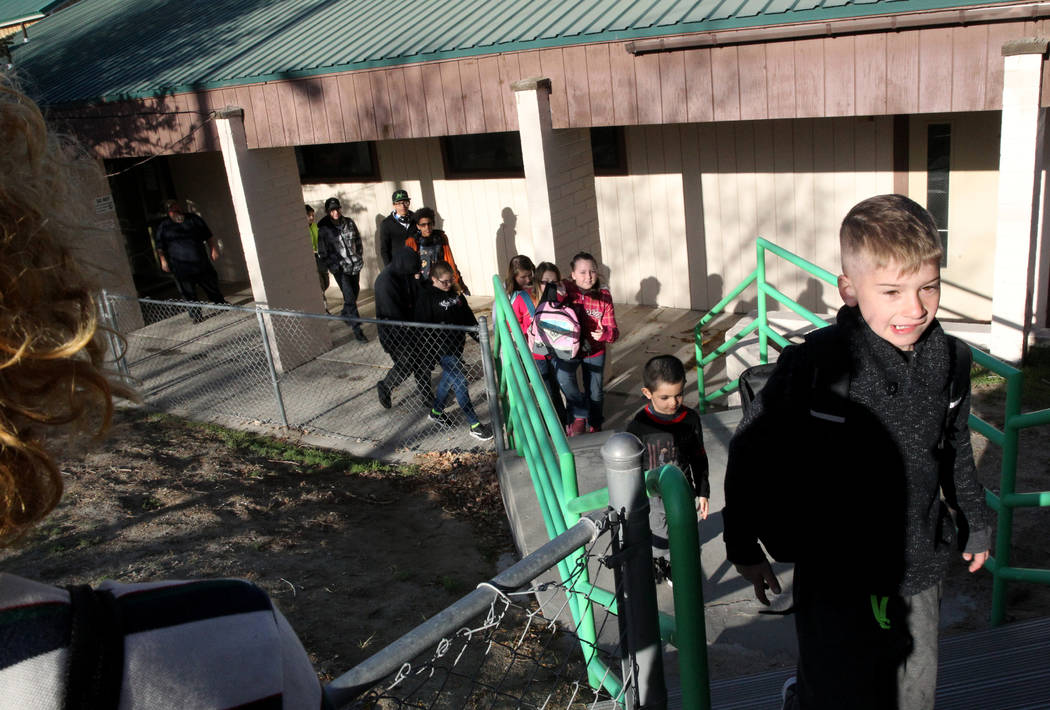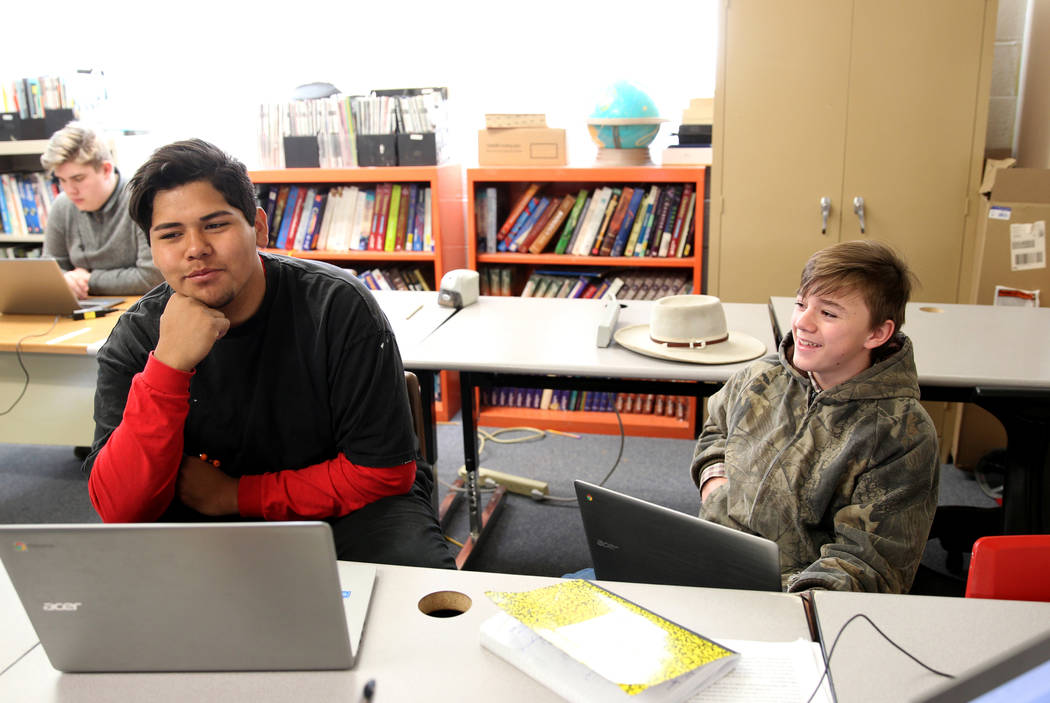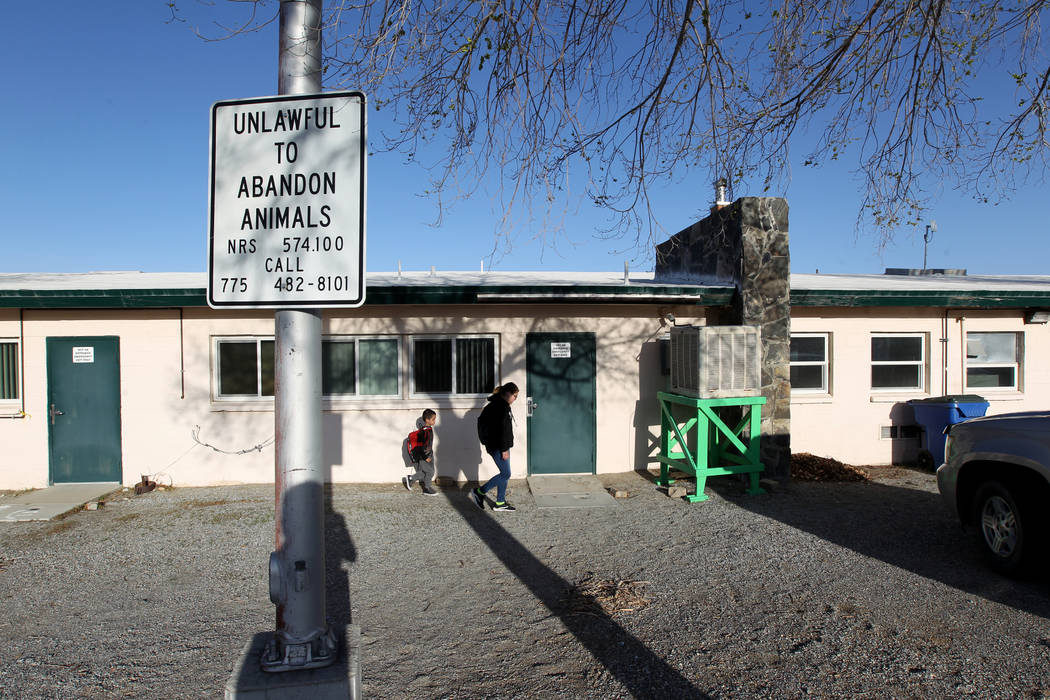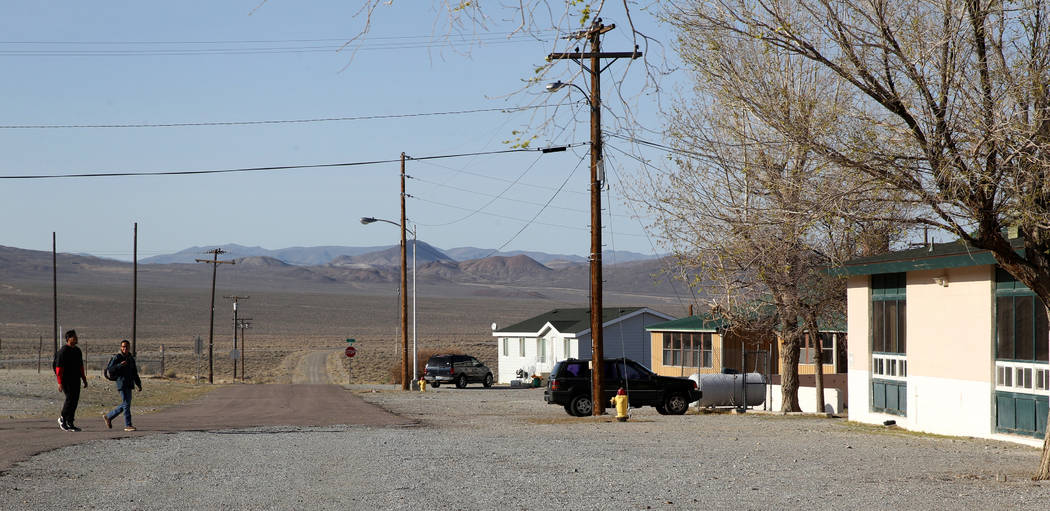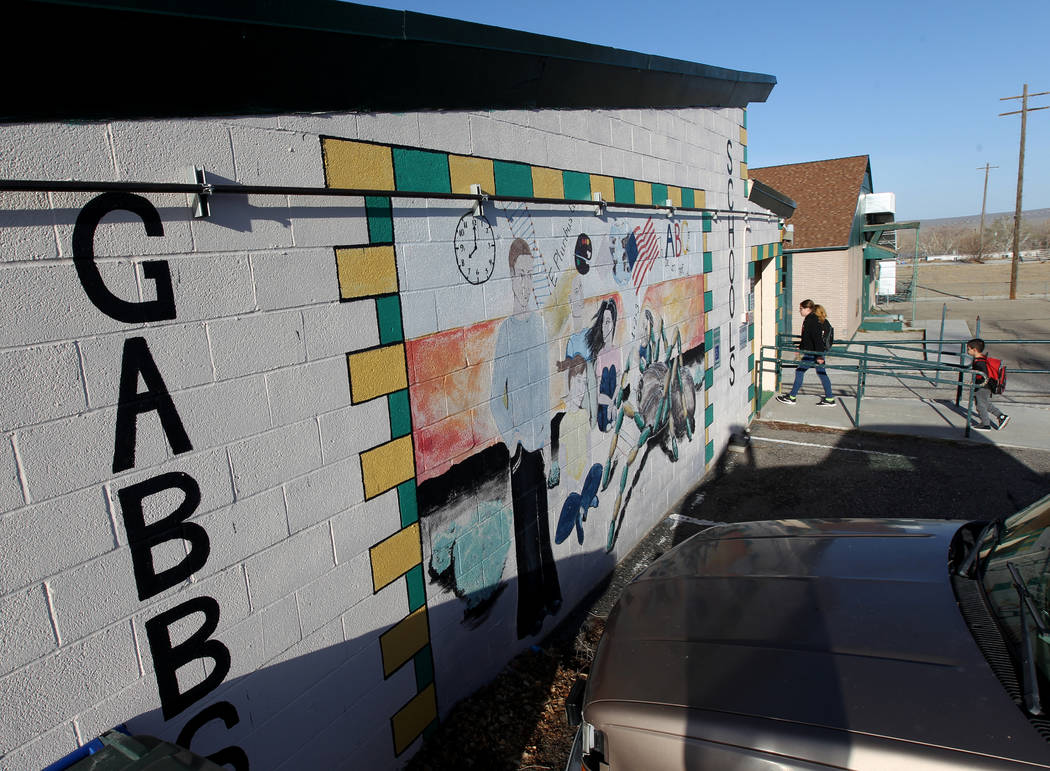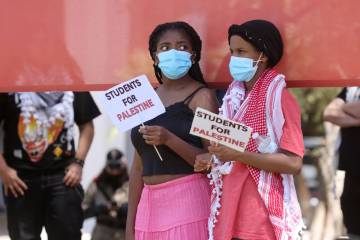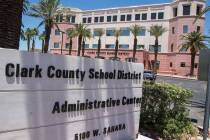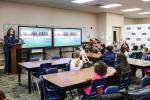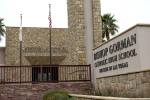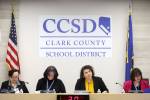Nevada school is throwback to days of one-room schoolhouse
GABBS — The two teenagers have struck up an odd-couple friendship that could likely take place in only a few schools across the American West.
Dave Jim is a strapping 15-year-old, a barrel-chested, soon-to-be 11th-grader who weighs 220 pounds. His best buddy Devin Gaither is a plucky 13-year-old who barely tips the scales at 110 pounds.
Both the products of local ranch families, the boys sit next to each other in this tiny rural school, located in the far northern reaches of Nye County, along a desolate stretch of state Route 361.
Gaither, for one, is amazed by their closeness.
“It’s nice to have a friend like Dave,” he said. “If we went to a regular school, he’d probably be one of the kids who’d be mean to me.”
But the Gabbs School is not regular, not by a long shot. It’s one of a handful of academic environments across Nevada with an unusual teaching method: Jim and Gaither are among a dozen students between the seventh and 12th grades with a single instructor, in this case retired Air Force veteran and insurance agent-turned educator Tom Lyman. Down the hall, kindergarten through sixth-grade students are taught by another teacher.
The new school year starts Aug. 13, and buying new clothes and supplies is typically a challenge for Gabbs residents. For Crystal Howell, who has three children attending the school, it means putting the rubber to the road: She and her family must make the 320-mile round trip to Reno — not just to find the latest styles, but anything at all.
“It’s a lot of traveling,” she said. “So we make a day out of it.”
And the road trips don’t stop there. “Once basketball season starts,” said Jim, “we’ve got to drive a long way just to find sneakers.”
Summers spent in an isolated town in central Nevada’s hinterlands, without malls or movie theaters, means boredom is a constant.
For Timothy Howell, a 14-year-old entering the 10th grade, August couldn’t come fast enough. “You get tired of just riding your bike,” he said.
That’s OK with his mother. “The one plus is that there’s not a lot of girls in town, so I don’t have to worry about that,” Crystal Howell said.
Throwback to earlier era
The educational arrangement in Gabbs is a close cousin to the one-room schoolhouses where generations of Nevada pioneers received their educations.
Falling populations in rural Nevada’s mining and agricultural-based communities mean there aren’t always enough students to fill out each grade. That has given rise to what are known as remote rural schools.
“Even though populations drop in these rural communities, we have to evolve and keep pace,” said Humboldt County School Superintendent Dave Jensen, who oversees a handful of such schools in the state. “We have to make sure our kids, even in the most remote locations, are exposed to a 21st-century education.”
For students, that means taking courses via the internet, spending their days peering at a computer screen. Their classroom resembles a collection of home-schooled students who have gathered in one place.
Nye County School Superintendent Dale Norton said the Gabbs School is doing its job. “Parents said they wanted their kids to graduate right there in town,” he said. “They didn’t want them on a bus for an hour and 40 minutes to another high school.”
There are drawbacks to such a no-frills education: no prom, no hallways teeming with teenagers, no Friday night football games and no art or music classes.
‘I can be myself’
But that suits some rural students just fine.
“I’m not really good with strangers. I’m not exactly talkative,” said 16-year-old J.J. Thompson, who is taking some college-level courses. “In regular school, you have to be outgoing. What I like about my school is that I know everybody. I can be myself. We’re more than classmates. We’re family.”
His father, Jim McKinnon, graduated from Gabbs High School in the 1997 class of 10 and now works as the school’s custodian. (His wife, Crystal Howell, is Lyman’s aide.)
McKinnon attended a regular high school with all the major sports. Now he and his wife must fill in the gaps to make sure J.J., the eldest of three children, has a normal teenager’s life. They take him to dances at the high school in Tonopah. “As parents, you have to step in,” he said.
He likes the setup in Gabbs. “This school is what you make of it,” he said. “If you want to succeed, it’s the perfect setup. Kids who aren’t self-motivated get lost in big schools. But not here. In Gabbs, the teachers are here to push you.”
The classroom can be chaotic. Each day, the shirt-and-tie-wearing Lyman fields a barrage of questions. “I’ve got a dozen students, each taking a different course, so I’m dealing with seventh-grade math, eighth-grade grammar and 12th-grade government,” he said. “Geometry isn’t my strong suit, so I end up taking courses like that right along with many students.”
Town soldiers on
Gabbs, named after paleontologist William Gabb, was founded in the early 1940s as local mines competed to meet World War II demand for magnesium fuel. In 1943, Gabbs became a township with a population of 426 and featured a library, a city hall, several parks and a local newspaper. It incorporated as a city in 1955.
In the 1980s, the population reached its peak of nearly 1,600, thanks to an influx of mine workers. At the time, the elementary, middle and high schools drew 175 students, and some classes featured nearly two dozen graduates.
Then the mining economy collapsed. In 2001, the population of Gabbs fell below the level necessary to keep its incorporated status. As people moved away, the grade and middle schools were shuttered, and sections of the high school were closed.
Today, 150 people hang on in Gabbs, which offers a bar, a convenience store, a gas station and a motel. The school’s 2015 graduating class featured four students. The 2016 class had two, and in 2017 and 2018, each graduating class had just one. When Lyman started at the school in 2011, fresh after earning his teaching degree, the high school had four teachers and the elementary school three. Now they’re down to one apiece, with an aide to assist.
“This classroom might overwhelm a 23-year-old teacher fresh out of college,” Lyman said. “But I’m an old fart who’s seen a bit of the world. Still, I don’t do much teaching per se. I just help them understand what’s on the computer screens.”
One morning last spring, the K-6 group met the older students in the hallway in front of the office to recite the Pledge of Allegiance. As an aide helped roll up the flag, the students sang the state song, “Home Means Nevada,” which begins, “Way out in the land of the setting sun/Where the wind blows wild and free/There’s a lovely spot, just the only one/That means home sweet home to me.”
Then the high schoolers filed back into their classroom, past a sign on the wall that harks back to earlier days: “No Cellphones: Any Device that is Visible is Considered in Use.”
But times have changed. “I just never took it down,” Lyman said of the sign. New rules ban social media texting but allow students to listen to music through earbuds once their lessons are done.
Teaching independence
Lyman walks a fine line with his disciplinary strategy.
With an average GPA of 3.1, most of his students are performing at levels beyond their statewide peers. Each must complete several lessons a day, goals divided between morning and afternoon sessions. If they don’t earn a C grade, they must repeat the class. Because they work independently, some finish their lessons early.
“I’m trying to teach them independence,” he said. “And I know if there were too many rules they would rebel. Students will say, ‘I’ve done my work. Why can’t I talk? And I’ll say, ‘Fine, but keep it down.’ It’s working well. The kids are doing great. So I just let things go, as long as it’s not crazy.”
With district money Lyman bought such incentives as a telescope for after-hours stargazing and an Xbox video game system for students with free time. He’s paid for many games out of his own pocket. Twice a day, students break for a half-hour gym session to play basketball and blow off steam.
In this class, there are no hall passes. Students move about freely. If they have to use the restroom, they just get up and go. But Lyman sometimes has to lay down the law.
“Hey guys, no chips!” he says this day in response to the sound of rattling snack wrappers. “Put ’em away, and I don’t mean just stuffing ’em in your mouth.”
After a gym break, freshman Louis Afraid-of-Hawk, a 15-year-old American Indian, took a seat at a study computer in the Xbox gaming room.
“C’mon back,” Lyman told him.
“Nah, I’m gonna work over here.”
“No,” the teacher responded patiently, “you need to come back to the classroom.”
Back in the room, 16-year-old Christa Gentry raised her hand.
“Mr. Lyman?” she said. “I’ve changed my mind. I need help.”
Gentry is one of two girls in the class. A year ago, she played on the junior varsity co-ed basketball team, the Gabbs Tarantulas. She’s self-assured: “I wasn’t much of a scorer. I was more like a wall for them.”
Lyman leaned over her computer and coached her through a few science questions. Later, Gentry told him, “I hate biology.”
“You got it done, though,” he answered.
Gaither is the youngest student here. His cowboy hat set aside, he props his boots on a desk and listens to music on his phone, still dressed in his Carhartt work jacket. Behind him, on the wall, hang posters of a human skeleton and phases of the moon.
He’s done his schoolwork. Now it’s time to be a teenager. When class finishes, he’ll ride his minibike a mile home to his nearby ranch.
Maybe he’ll hang out with his best friend, Jim, theirs an unlikely bond that might not happen anywhere else but in a rural school in a remote Nevada town like Gabbs.
John M. Glionna, a former Los Angeles Times staff writer, may be reached at john.glionna@gmail.com.



